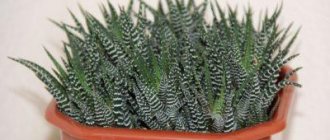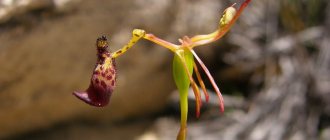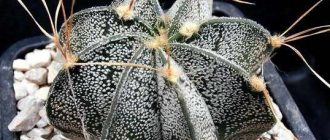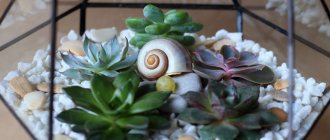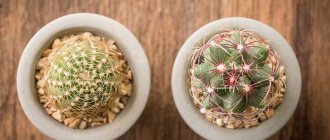The homeland of the cactus is not always a desert, as is commonly thought. Most often they grow in wildlife in more suitable areas. Desert types of succulents are more like dried thorns, although life still glimmers in their depths, which blossoms with the penetration of life-giving moisture. In many cases, the homeland of the cactus plant is the territory of modern Mexico and Colombia. Here and now, a huge number of species of succulents grow, adapted to a hot and arid climate, in which periods of dry winds give way to rainy seasons.
You can learn about where cacti and succulents are common in wildlife and where they grow from this article. It will provide reliable information about the distribution areas of these plants.
Hot and inaccessible South America is the real birthplace of the Decembrist houseplant
Many who are involved in breeding indoor plants have already found out the homeland of the Decembrist plant a long time ago in order to properly navigate how best to care for it, what conditions to create and what to feed it ideally. As we have already said, this is an epiphytic cactus, completely devoid of needles, which mainly grows in the warm tropical forests of South America, on snags, stumps, and also directly on tree trunks, in conditions of significantly increased humidity. Thus, the homeland of the Decembrist is known, it is not a secret, let’s figure out how he got from there to our comfortable conditions of city apartments and private houses.
Decembrist flower: origin of the name
Those who are interested in the birthplace of the Decembrist should first figure out where its scientific and colloquial name came from, and only then move on. In the mid-nineteenth century, a famous botanist and breeder, as well as an avid collector from France, named Frederic Schlumberger, first proved that the Decembrist was indeed a cactus when he grafted its shoots onto Pereskia spinosa. Another scientist, a taxonomist named Charles Lemaire, decided that the scientist deserved to perpetuate the name of his colleague, so this cactus was called Schlumbergera, in the German manner of pronunciation.
True, for the most curious, it is worth clarifying that there is another scientific name for the Decembrist, namely zygocactus, which comes from the Greek word meaning “yoke”. Moreover, to be honest, the birthplace of the Decembrist flower has absolutely nothing to do with it, and the name is based on the fact that the stems of the plant, consisting of segments, are always divided exclusively in two. That is, in living nature, one shoot can produce two, but three, four or more will never grow. True, it should be recognized that selection, that is, bred species can already produce three or more shoots, as well as several flowers on one.
The name Decembrist, which is familiar to us, appeared thanks to a growing season unique to our latitudes. The homeland of the Decembrist plant gave us a similar gift, for which we are immensely grateful to her, because it blooms in December and can continue to bloom until March. Thus, it becomes completely clear not only where the Decembrist flower comes from, but also why it bears such a name. It turns out that hot Brazil can definitely be called the country of origin of the Decembrist, as well as Argentina, Peru and even a little Mexico, where this species most often grows.
Families and types of cacti.
You will have to obtain knowledge on proper care and creating the best living conditions for plants from specialized literature. Therefore, you need to know that, according to their characteristic features, cacti are divided into subfamilies, tribes, subtribes, genera, species, varieties, and forms. All plant names are given in Latin.
Latin names reflect the cactus’s belonging to a certain natural species and the relationship of this species to a certain genus. Therefore, double Latin names are used in botany. The first word is written with a capital letter and indicates belonging to the genus; the first and second (the second is written with a small letter) together make up the name of the species. Next is the abbreviated name of the author - the one who first gave a scientific description of this species. If a species has varieties, they are designated by the third word in the name, preceded by the abbreviation “var” (from the word - varietes - variety). There are also various forms of plant species, this is indicated by the abbreviation “f.
There are three subfamilies in the cactus family:
- peireskiaceae;
- prickly pear;
- Cereus;
The Peireskiaceae subfamily is the smallest of them. It includes only 29 species. According to Backeberg they constitute three genera. All plants of this subfamily are weakly succulent. These are mainly shrubs, although there are also tree-like plants. They retained regular, fully developed, succulent, dark green leaves. These are the most primitive of cacti, so it is believed that other cacti originated from them.
Large specimens of this genus look like ordinary trees. They have distinct areoles on their trunks. They are grown mainly in greenhouses. Species with strong shoots are used as a rootstock for many epiphytic cacti (epiphytes are autotrophic plants that have no connection with the soil and settle on the branches and trunks of other plants). Peireskia aculeata (Plum) Mill is commonly found in indoor culture, with very fragrant flowers that open widely (up to 7 cm in diameter) and have numerous yellow, orange or pink stamens. Peireskia sacharosa and others are very simple to cultivate. Often used for vertical gardening of premises. The popular name of these plants is rose cactus.
The opuntiaceae subfamily includes 16 genera and about 450 species. Here you can observe all kinds of transitions from small species creeping along the ground to highly branching, lush shrubs and real trees (up to 6 meters in height). The main distinguishing feature of prickly pears is the presence of glochidia sitting in the areoles - these are tiny, very fragile hairs, covered with numerous hook-shaped outgrowths looking down, arranged in a tuft. With the slightest touch, the glochidia easily break off and become embedded in the skin and clothing. Getting rid of them can be difficult.
The subfamily Opuntiaceae is divided into three tribes:
- fidlopuntia;
- euopuntia;
- pseudopuntia.
Euopuncia is the richest of them: it has 16 genera and almost 500 species and consists of three more subtribes.
The Cereus subfamily is the largest, comprising more than 2,000 species belonging to 224 genera, which makes up 80 percent of the entire cactus family. This subfamily is divided into two tribes. The first (Hylocereeae) includes epiphytic cacti, highly branched with aerial roots. The second (Cegeaeae) includes a lot of cacti, which, based on external characteristics, divide this tribe into a number of subtribes and groups. The subtribe Austrocactinae alone includes almost 100 genera. Most cacti of this subtribe are beautifully flowering.
The taxonomy of cacti is a controversial issue. Clarifications and additions are often made to the system of the cactus family; names change. Therefore, when working with reference literature, look for information about your cactus by both generic and species names.
Modern publications, as a rule, are equipped with atlases with color photographs of the most common cacti, which makes it easier for a novice cactus grower to find information.
If you decide to form a collection, then do not be lazy from the very beginning to create an individual “passport” for each new plant, in which, in addition to the full name, indicate basic background information: the historical homeland of the plant, its age, where and in what form it came to you , what are the basic requirements for lighting, soil watering, approximate time of flowering and fruiting. In parallel with the collection, without much difficulty, your card index is compiled. You can enter all the data into your home computer.
Author: PB Mkrtchyan
Where do cacti grow in nature: habitat conditions
Features of caring for pets
The homeland of the prickly plant cactus (from the Greek cactos) is South and North America. The center of family formation is still considered to be South America, from where they spread to the North American continent. Where cacti grow, there can be completely different conditions, because these plants have a huge distribution area, covering different natural zones. This in itself determines a wide variety of plant growth conditions: climatic, zonal and soil. Cacti inhabit tropical forests (epiphytic species growing on tree trunks), savannas, various types of deserts and semi-deserts, and in the mountains they rise to an altitude of 4500 m above sea level. Where else do cacti grow in the wild? Most of these succulents are adapted to life in desert conditions, with little rainfall and sharp temperature changes from day to night. Particularly harsh environmental conditions for cacti are characteristic of high-mountain deserts with their negative night temperatures and the difference between day and night temperatures on the soil surface up to 45°. To the north, the range of cacti extends to 56° N. sh., and south to 54° S. w. The extreme points of the range are reached mainly by representatives of the Opuntaceae subfamily.
The habitat of cacti across continents is extremely uneven. The greatest species diversity is characteristic of Mexico, the mountain deserts of Peru, Chile, Argentina and Bolivia.
Cacti are plants that have high ecological plasticity. Certain signs of cacti's adaptability allow them to survive not only in North and South America, but also in various natural zones of other continents. Thus, some types of prickly pear were brought to Western Europe and successfully acclimatized. In the former USSR, prickly pears were acclimatized in the Crimea and Astrakhan region, as well as in Turkmenistan. Some types of epiphytic cacti are found in the forests of Africa, Madagascar, Sri Lanka and the islands of the Indian Ocean. However, it is believed that they were brought to these places by humans.
Blooming cacti in the house
In order for cacti to grow properly, they must be grown according to their life cycle. Succulents need to provide conditions that will allow them to alternate periods of development and dormancy. These plants require very sunny and warm locations, as well as penetrating, nutrient-poor soil. Be careful with watering and fertilizing.
Application
How to care for succulents?
All parts of this plant are used in different fields. Flowers, cladodes, berries are used in:
- Cosmetology
- Cooking
- Agriculture
- Traditional medicine
Prickly pear flowers produce valuable oil that has anti-aging properties. It is used in the preparation of face and hair masks. It is also added to anti-aging creams. Vitamin E restores cellular structure, increases the turgor of the epidermis, nourishes and moisturizes it. This is an antioxidant that helps prolong skin youth.
Organic acids obtained from cactus pulp are used to make masks and creams for dull skin. Their use helps tighten problem areas of the face and neck and regenerates the cellular structure. Prickly pear fruit extract is added to tanning products and ointments for burns.
Cactus branches and leaves are fed to domestic animals. Thorns are removed by burning the collected parts of the plant. After heat treatment, the pulp becomes softer and more palatable. For feeding, fodder species of prickly pear are used, which are grown specifically for this purpose.
Prickly pear juice is used in folk medicine. Compresses are made from it to heal wounds and accelerate bone healing in case of fractures. These procedures also help with rheumatism and joint pain. Local residents use decoctions of dried fruits to treat vitaminosis and diseases associated with weakened immunity. Berry tincture helps against urinary tract diseases. Drinks from the flowers and roots of the plant improve the functioning of the prostate gland in men and prevent prostatitis.
Not only prickly pear berries are used in cooking, but also the pulp. Young shoots, the size of which is no more than 10 cm, are suitable for consumption. They are cut and eaten fresh or processed. Cladodes can be dried, pickled, stewed, baked. The Indians have long made various drinks using the pulp of cacti.
Prickly pear fruits have a more delicate and pleasant taste. They are eaten raw, and the following dishes are also prepared from them:
- sweet salads;
- jelly, marmalade;
- candies;
- preserves, jams;
- juice, wine, cocktails.
Magnificent cactus: the plant’s homeland, the necessary soil composition and other growing features
In the modern world, scientists have already studied and classified more than two thousand species of a wide variety of cacti, which differ very noticeably in shape and size, color and the conditions required for their cultivation. Contrary to prevailing stereotypes, cacti for the most part do not tolerate direct sunlight, love moisture, and some species do not bloom at all, while others are able to decorate our lives with amazing, fantastic flowers. What can a cactus and its homeland tell us about itself, about the characteristics and growing conditions of these strange, but so attractive plants.
The right pot is the key to success
Photo from the site: Koffkindom.ru
Before you get your act together and finally decide that you will grow these particular plants, you need to understand that the homeland of the indoor cactus has given it a rather capricious nature. That is why it is extremely important to choose a container for it that will exactly correspond to its not very branched root system. In order to decide what kind of pot you will need, you will have to remove the selected cactus from the temporary container and carefully examine the rhizome. Usually it is not very long, but quite branched; for such specimens it is advisable to take low but wide vessels.
However, some cacti have quite long roots, then it is worth thinking about deeper pots. It is optimal to use a variety of ceramic containers, as well as glass and, in extreme cases, plastic, which practically do not interfere with the growth and development of cacti. But metal pots are completely unsuitable for growing cacti, since corrosion products can destroy the root system and cause it to rot.
Suitable soil composition: making the life of a cactus as comfortable as possible
Photo from website: from.by
An extremely important and responsible process is the correct selection and preparation of soil that would be best suited for growing a wide variety of cacti. In our black soil, cacti will not feel the best, because it is fatty and heavy, huddling into a tight lump, which is not at all the norm in the homeland of the cactus flower. Moreover, the choice of soil qualities will directly depend on the type of cactus, as well as the conditions of its growth in the natural environment, but there are some general recommendations, which are worth studying in more detail.
The main ingredients of “light” soil for cacti
- Old soil from greenhouses or greenhouses.
- Leaf soil.
- Clay-turf soils.
- Washed coarse river sand.
- Brick chips, as well as charcoal.
Among other things, you should definitely take into account that cacti love airy and light soil, in which the roots of the plant will grow comfortably. But looseness is not at all the main indicator; the main thing is that the acidity level ranges from five to six and a half, as in the homeland of the cactus plant.
Photo from website: agroopttorg.com
It is also necessary to always remember about drainage, which should make up at least a third of the total soil in the pot with the plant. Stagnation of water in pots is simply unacceptable, since otherwise the roots will inevitably rot and the cactus will die. For high-quality drainage, anything will do, for example, crushed stone, red brick chips, expanded clay and even ordinary polystyrene foam, if nothing else is at hand at the time.
Botanical description
Indoor flowers that should not be kept at home. photo
Cactus is a perennial succulent from the Cactaceae family.
Botanists divide the family into four groups:
- Pereskiaceae (pereskioideae) - a transitional form between cacti and plants with leaves, consists of 1 genus;
- prickly pear (opuntioideae) - includes 18 genera, all have clearly noticeable reduced leaves and small fragile spines with serrated serrations, collected in bunches around the areoles;
- maihuenioideae - includes one genus, common in the south of South America, similar in appearance to prickly pear, but without thorns;
- cactus (cactoideae) - unites all stem succulents that do not have leaves.
Cactus is a dicotyledonous plant. When grown from seeds, shoots consisting of two cotyledons will appear on the soil surface. For a cactus grower, this is of practical importance: in dicotyledons, thickening occurs due to the expansion of the cambial ring, which makes it possible to graft one specimen onto another.
Cacti have a special organ - the areole. These are pads topped with spines. Areoles are modified buds and correspond to branches. They allow you to distinguish cacti from any other plants (see photo).
The first areoles appear on seedlings, at about two weeks of age. Then they develop spines, hairs, flowers and fruits.
Visually, the areola can be divided into two parts. At the top there is a growing point, buds develop. The lower part produces spines.
If you damage the part of the areola where the growth point is located, the pad will stop growing. Then one or more neighboring areoles will take over its tasks. As a result, children or branches will appear. This is how additional crowns are formed, growing independently of each other, which is why their shape becomes bizarre.
Based on the location of their areolas, cacti are divided into two groups:
- monstrous - pads are evenly scattered along the stem;
- crestate - the areoles are located one after another, forming a ridge.
The size and shape of aboveground and underground organs are extremely diverse. The fruits are called berries. They can be the size of a millet grain or a large plum, but they are always typical berries, since inside they are many small seeds embedded in the pulp.
Do cacti need water?
During the rainy season, cacti store water in their stems, absorbing it through their highly branched but shallow root system. Their leaves changed and became thorny. The stems became ribbed to make it easier to shrink when losing moisture.
During periods of drought, cacti can greatly shrink in volume, losing water by 60-70%. The beginning of the rains quickly restore the plants. The ability to create water reserves varies among different cacti, because they differ in size and shape. But in nature there are such amazing species that are capable of storing up to 3000 liters of water in their stems. It is these heavy, weighing more than a hundredweight, giant Carnegia and Mexican spherical cacti, Academician N.A. Maksimov very aptly called them hoarding plants. Carnegia can survive without additional water supplies for a year.
Carnegia giant cactus
Cacti are covered with a thick cuticle (from the Latin cuticuia - skin) and use water very sparingly. In many species, the cuticle is covered with a waxy layer, which under the influence of sunlight can acquire different shades. At the same time, they tolerate high temperatures well, being the most heat-resistant flowering plants on the planet. They say that some cacti can tolerate heat up to 62 degrees and even a little higher without much harm. All cacti are covered with spines of various sizes and colors. They can live for many years even in a closed flask with moist soil.
All these properties were developed in plants gradually due to the need to adapt to the arid and hot climate of their habitats.
Where are you from?
Since the cactus is not one species, but many varieties, it is difficult to identify any common homeland for all this biological abundance. It is often said that the cactus owes its origin to the entire continent of North and South America, where it grows in arid conditions from the arid Wild West of the United States to Argentina and Chile. For most species this statement is true, but cacti also include some species that appeared in continental Africa and Madagascar. In addition, through the efforts of Europeans, these plants spread all over the world, so in some warm countries of Europe, some species are also found in the wild. Even in the south of the Russian Black Sea region such plantings can be found.
However, Mexico is considered to be a kind of capital of cacti. First of all, there are really a lot of them on the territory of this country; the plant is found almost everywhere, even in the wild, while about half of all known cactus species grow here. In addition, in most regions of their origin, cacti grew wild, while the ancestors of modern Mexicans (not to mention our contemporaries) actively bred some species for various needs, turning the plant into an indoor one. Nowadays, representatives of the cactus family as indoor plants around the world are perceived exclusively as decorative decorations. The ancient Mexicans also used this property of green spaces, but the possible use of cacti was not limited to this.
From the sources of the Spanish conquerors and the legends of the local Indians, it is known that different types of these plants could be eaten, used for religious ceremonies and as a source of dyes. In some regions, cacti can still be used for the same needs. For the Indians, the cactus was everything - they made hedges from it and even built houses. European conquerors were not overly concerned with the classification of crops grown by the conquered peoples, but information has reached us that at least two species of cacti were grown in Central America for sure.
Today, this plant in its various forms is considered the national symbol of Mexico, so if one country is considered its homeland, it would be this one.
There is also a theory according to which cacti originally appeared in South America. According to the authors of the assumption, this happened about 35 million years ago. These plants came to North America, including Mexico, relatively recently - only about 5-10 million years ago, and they came to Africa and other continents even later, along with migratory birds. However, fossilized remains of cacti have not yet been found anywhere, so such a point of view still needs to be confirmed by weighty arguments.
Care procedures
In order for cacti to grow properly, they must be grown according to their life cycle. Succulents need to provide conditions that allow them to alternate periods of development and dormancy. The dormant period usually occurs in winter, then it is necessary to limit watering and lower the temperature to approximately 12-15 degrees. The wintering temperature differs for different species: frost-resistant cacti can overwinter at a temperature of about 5⁰C, heat-loving cacti require a higher temperature - even 18⁰C. After a period of dormancy, cacti must be hardened off before returning to their permanent location. Flowering species should set flower buds in approximately 3-6 weeks. Most cacti bloom in May and June.
We replant the cacti in the spring into slightly larger pots than they have grown so far. We water them only after a few days. We don't fertilize!
Cacti can be attacked by pests such as mealyworms and spider mites. Infected plants should be sprayed with an appropriate chemical. The most common diseases are soil fungal diseases.
Selenicereus
The genus Selenicereus belongs to the Cactus family and has 24 species of plants of various habitat forms. This cactus is native to the tropical forests of South America. The peculiarity of this species is long and narrow shoots with ribs and aerial roots with which the plants cling to the supports. Unfortunately, out of the entire variety of species, only three are cultivated. The most common is Selenicerus grandiflora, and less known: Anthony and Hooked.
Selenicerus has the largest flowers. They reach 30 cm in diameter, have many long stamens and have the amazing ability to bloom at night; flowering stops with the arrival of dawn. For this feature, the plant received the name “Queen of the Night”.
Selenicerus, like all similar cacti, loves a lot of light, so it is better to place it on southern windows. Feels great at temperatures in central Russia. But it does not tolerate drafts and sudden changes in temperature - in such conditions it drops its buds. It should be watered when there is no moisture in the pan and the top layer of soil has dried well. Water should be soft, settled or filtered at room temperature.
Cactus propagation
Growing from seeds
Cacti reproduce by seed and vegetative methods, namely by children or cuttings.
Growing cacti from seeds has its own difficulties: you will need to pre-sterilize store-bought seeds - they are soaked in a pale pink solution of potassium permanganate for half an hour. It is also necessary to sterilize the substrate - steam it or fry it in the oven at a temperature of 110-130 ºC. The moist substrate is poured into a container in a layer of about 1 cm, the prepared seeds are laid out on it, after which the crops are covered with film or glass.
The soil is kept slightly moist at all times, and the crops are ventilated twice a day. It will take from several days to several months for cactus seeds to germinate. When the first thorns appear on the seedlings, they are transplanted into a more nutritious substrate, and at the age of several months they begin to be cared for like adult plants, but protected from too sudden temperature changes and watered more often.
It is better to sow seeds so that seedlings appear in early spring.
- How and when to plant cabbage seedlings
Reproduction by children
It is easier to propagate cacti vegetatively: many plants produce babies with rudiments of roots. The children are easily separated, after which they are placed on a moist substrate into which their roots grow, forming a root system over time. Select a larger baby, separate it with a sterile instrument, dry the cut site for 3-4 days and root the cutting in a moist substrate.
Indoor cacti
Dwarf cacti are grown indoors and take up very little space. They can be grown on the same windowsill for several decades.
Cacti, like many other indoor plants, need a period of rest, which occurs in winter. Therefore, the main task when caring for cacti is to prevent growth in winter, because during the winter they stretch out and lose their usual appearance. In winter, cacti can be grown on windowsills. To keep the roots cool, the pots should be placed on a stand.
Cacti like these need leaves in the brightest places, but other cacti also love bright light. In winter, it is best to maintain the temperature around 15-18 degrees. Desert cactus can withstand temperatures as low as 5 degrees. and in winter it can be kept in unheated rooms.
During the dormant period, in winter, watering is done once every 7-10 days. It is better to take warm water, a few degrees higher than the air temperature. When watering a cactus, you need to make sure that water does not get on the cactus stem, especially in winter. Water penetrating into inconspicuous cracks on the stem leads to rotting of the plant.
With the onset of spring, cacti should be watered more often and sprayed several times a month. In summer, cacti must be protected from direct sunburn. To prevent the pots from overheating, it is better to place them in boxes filled with soil or peat. You can take the boxes with cacti out onto the balcony. It will be more useful to plant large specimens in the ground in the garden. In mid-August they need to be transplanted into pots again so that they have time to take root before winter.
Watering a cactus depends on the size of the pot, time of year, age of the plants, and room temperature. During the growth of cacti, in spring and summer, they need to be watered daily.
Old cacti need to be watered less often because they have large reserves of water. Especially in summer, abundant watering is required. It is advisable to water in the evening. The lower the air temperature, the less you need to water, since cacti evaporate less water. Watering in the fall is gradually reduced, and in winter it is rarely watered at all. If cacti are watered frequently in winter, they do not enter the dormant period, become exhausted and do not bloom.
It is better to replant cacti in the spring, when they begin to grow. A couple of days before transplanting, you need to stop watering them so that the soil leaves the roots more easily. The cactus is wrapped in strips with a strap or thick paper, then knocked out of the pot. Rotten and dead roots are cut down to living tissue. The sections should be sprinkled with charcoal powder.
All flowering cacti in early spring require replanting immediately after flowering. After transplanting, they are not watered for several days.
Growing conditions
In their natural environment, cacti grow in climates where there is very little (or no) rainfall and the soil is sandy or rocky, very poor in nutrients, and completely infertile. They mainly grow in very sunny places, in dry and hot climates. However, there the temperature can periodically drop to several degrees above zero, and sometimes there can be a slight frost. Cacti have adapted to such extreme climatic conditions - they know how to store water and limit its evaporation.
In order for cacti to grow at home, they should be provided with conditions similar to those in nature. First of all, they should grow in a very sunny and warm place - the best place would be a south-facing window sill or a special flower window or greenhouse .
Cacti must grow in a special substrate intended for succulents, which must, above all, be permeable to water. The soil for cacti should be sandy, dry, poor in nutrients (simply sterile), and slightly acidic. Coarse sand or gravel can be added to the substrate. It is necessary to fill the bottom of the container with a drainage layer to ensure the free flow of excess water. Cacti require dry soil, so be careful with watering. We water them more abundantly only in the spring, at the beginning of the growing season. We limit watering in the summer, and in the autumn-winter period we water the plants very moderately, when the soil in the pot does not clearly dry out (even for several weeks).
Cacti naturally grow in infertile soil, so they do not require frequent fertilization. We fertilize these plants several times during the growing season - from May to the end of summer. For feeding, it is best to use special fertilizers intended for cacti, which have a balanced composition. You should not fertilize cacti immediately after planting and in the autumn-winter period and early spring.
Beautiful Decembrist flower: the flower’s homeland determines reproduction and pollination
Having figured out the name of the Decembrist and its homeland, you can go further and understand a little about what kind of plant it actually is, how it feels in nature, why it is interesting and entertaining. This cactus has absolutely no leaves, as well as the usual spines for almost all cacti. The country of origin of the Decembrist flower gave it stems that are slightly flattened at the edges, and also, depending on the species, with or without jagged edges, which, according to biologist research, are atrophied spines.
Schlumbergera almost does not grow in height, only about twenty to thirty centimeters, but the stems themselves can easily reach up to a meter in length. In fact, they are and are considered to be drooping, and at their edges beautiful and fleshy, mostly two-tiered flowers are formed, with pistils and stamens sticking out. The Decembrist cactus, whose homeland is located in the humid and impassable “lungs of the planet”, that is, the jungle of the fertile Amazon River, has a cross-pollination mechanism, just designed for tiny hummingbirds, and in extreme cases, perhaps also hawk moths, and this is incredible, but true.
That is, you will never get fruit unless you yourself play the role of a small bird or a large butterfly, so if you decide to grow a Decembrist from seeds, you will have to work hard. It is clear that plants can be pollinated artificially, then it will produce red, beautiful and appetizing-looking fruits for birds and animals, which they spread throughout the wet jungle. The good thing is that where the Decembrist grows in natural conditions, there are plenty of them, and as one famous hero of the Russian comedy said, there are many wild monkeys in the forests who cope with the task of spreading seeds over large areas perfectly.
Popular message topics
- Why do people get scurvy?
Scurvy is a very terrible and life-threatening disease. A person can die from this disease. Until the 20th century, doctors around the world could not find a cure for this terrible disease. A large number of people died from it every year. - Wood mouse
There are many species of rodents around the world, including about 100 species of mice. The most common of them are field, forest and house mice. They are all very similar, but still have differences. This report - History and research of Antarctica
The vast and southernmost region of the globe is called Antarctica. But Antarctica is Antarctica and the adjacent shelf zones. Antarctica is washed by three of the four oceans - the Atlantic, Indian and Pacific. Continent area
Varieties
Often, when buying a store-bought plant, you can find many additives to the name, for example, “Rainbow” or “Red”. In fact, this is all just a trick. Novice gardeners are deceived by the attractive name, but in reality it is the same cactus that has simply been painted. In the best case, they used food coloring (red, purple, yellow, pink), and in the worst case, they used dyes from the printer.
If we talk about types, the following stand out among them.
Flat-spined
It can reach a length of two meters and a width of one and a half meters. Among the distinctive features, a small number of ribs stand out. The spines on the species described are gray, not curved. In Mexico, the cactus is actively used in the preparation of sweets, so at one time it was even on the verge of extinction.
Bet
At first it looks like a ball, then changes to a cylindrical shape. It is only 35 centimeters in height, the thorns not only bend, but also have an attractive pink color. It is not easy to grow at home; the variety has many care requirements. The seeds germinate poorly, and the plant itself has weak immunity to disease.
Horizontal
It is difficult to confuse it with its brothers, since its shape is very different from them. The outline resembles a ball, while the ribs are twisted in a spiral. Even in adulthood, such a cactus has a diameter of no more than 30 centimeters. The spines are quite thick, bright red. Compared to other Gruzon echinocacti, this makes it easier to achieve flowering at home.
After blooming, the flower becomes lilac-pink and reaches 3 centimeters in diameter.
Wide-needle
It is difficult not to pay attention to this species, since a huge number of spines are formed on its surface, the length of which can be up to three centimeters. When the plant blooms, yellow flowers resembling a funnel appear on its surface.
Multi-headed
This is the only variety that can please gardeners with needles of different colors. They can be pink, red, purple and other shades. In indoor conditions, the height of the cactus can be 70 cm; few spines are formed on the ribs.
Polycephalus
Very similar to a real hedgehog thanks to its numerous spines. Usually grows in groups, sometimes the number of such cacti reaches up to one hundred specimens. The characteristics are similar to the previous type.
Appearance
Cacti are very diverse in appearance and size: the smallest are only 1 cm, the largest reach sizes above 10-12 m in height. As for appearance, cacti can have a spherical, columnar or cylindrical shape. The stems can be single, branched, creeping, hanging, they can also climb on supports; there are species consisting almost entirely of turnip roots. Cacti have spines, which are transformed leaves. The spines can also differ in appearance - they can be very thin, barely noticeable, straight or curved with sharp straight ends, with a hooked end, hair- or wire-like, feather-like. Small, thin spines, called Glochidia , break very easily and are driven under the skin, and their removal is extremely painful and difficult.
Many types of cacti bloom at home - the flowers can last for several hours or several days. Depending on the variety, cacti bloom during the day or at night, the flowers appear at the top of the stem or at the base, and many of them emit a subtle aroma.
Transfer
It is not worth replanting a cactus immediately after purchase; any indoor plant must first acclimatize to new conditions before undergoing such stress. Some experts say that you can safely carry out the procedure after a year, others advise not to delay and change the potty after a month
In any case, it is worth taking into account the time of year, the condition of the cactus and other risk factors.
Some experts recommend avoiding replanting cactus altogether due to the fragility of its roots. But, be that as it may, over time, the roots will begin to extend beyond the pot not only from the top, but also penetrate into the drainage holes, and you will still have to change the container. Ideally, the plant should be replanted in early spring. Young plants are moved to a new container annually or once every 2 years, older plants - as needed or once every 4-5 years.
Spines and pubescence.
A distinctive feature of the cacti family is the presence on the stem of areoles (from the Latin area - area, space; diminutive form) - round spots of different diameters, in which there are radial and central spines, pubescences; in most cacti, flower buds and new shoots appear from the areoles. The upper and lower parts of the areola perform different functions: the upper is a potential growth point, buds and new growth appear on it in branching species; the lower part produces spines.
Cactus spines and various pubescences are very diverse in appearance and color. Thorns are peculiar remnants of leaves, which in arid climates gradually became smaller, and their veins turned into lignified tissue. Their purpose is double protection: both from eating cacti by animals, and as a means of saving the supply of moisture and replenishing this supply, since they actively absorb moisture from the air at night. Thorns and pubescences weaken the intensity of light and prevent the appearance of all kinds of burns on the surface of plants. The spines of cacti can be both long (up to several tens of centimeters) and short (from 1 mm); sharp and straight, as well as hook-shaped, wavy and curly. On the surface of plants they are located either singly or in a bunch. In some cacti, the central spines are much longer than the radial spines. The color of the spines makes cacti attractive at any time of the year and desirable in the collection. Even on one plant, multi-colored spines may appear. The color range is extremely diverse; red and white, yellow and golden, red and brown, transparent and almost colorless.
Video description
In this video you will see how to care for cacti so that they bloom:
How to properly organize lighting
Most cacti prefer bright sunlight. But you shouldn’t change the radiation intensity suddenly. To prevent the stem from getting burned, it should be shaded during the first weeks on a sunny windowsill. For this, white non-woven agrofibre or thin translucent paper is used. It should be fixed to the glass and removed after the plant has adapted.
Such succulents do not like bright light Source vsecveti.life
Video description
Watch the video for some more tips on caring for a cactus:
How to choose the right soil
In order for growing cacti to be successful, you need to select a light substrate into which air can easily penetrate. You can purchase ready-made soil mixture for cacti or make it yourself. To do this, you need to mix river sand, turf, and leaf soil. You can put expanded clay, brick chips or gravel at the bottom of the pot. They will serve as drainage.
Plant transplantation
A succulent needs to be replanted if the plant has stopped actively growing and the stem has begun to wrinkle and become dull. For some types of cacti, this procedure needs to be carried out once every two years, for others, once every five years is enough. There is no one rule for everyone; you need to monitor the condition of the succulent.
First of all, you need to protect yourself from injury. To do this, you can use gloves, or wrap the plant with thick cloth, newsprint or a washcloth. There are also special pliers for replanting cacti on sale.
Echinocactus transplant Source pocvetam.ru
The roots need to be carefully shaken out of the pot, cleaned of any remaining old soil, and dead or rotten roots removed. All cuts should be sprinkled with crushed charcoal, and the plant should be left in a dry container for the cuts to heal.
After this, you need to take a larger pot, put a layer of expanded clay on the bottom, sprinkle with a thin ball of soil, and carefully place the cactus. Using a rolled-up newspaper, you need to hold the plant strictly in the center and fill it with soil, making sure that the roots are evenly distributed in the container. Expanded clay or decorative crushed stone can be placed on top of the soil.
Plant after transplantation Source i.ytimg.com
You can water the plant after transplantation only after 15 days. All this time the plant should be in a partially darkened place.
This is how you can decorate the soil surface Source 2.bp.blogspot.com
